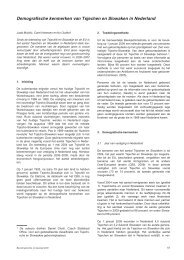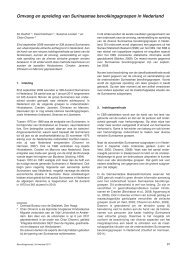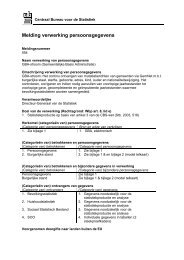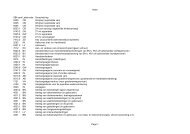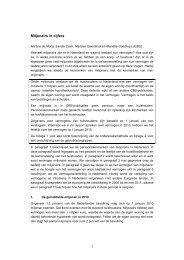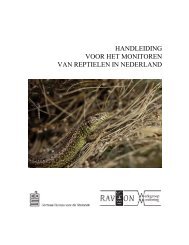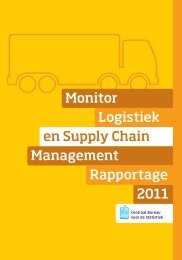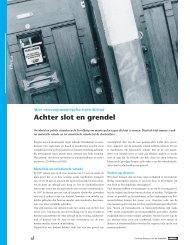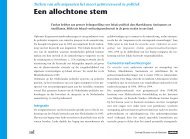Methoden voor de berekening van de emissies door mobiele ... - CBS
Methoden voor de berekening van de emissies door mobiele ... - CBS
Methoden voor de berekening van de emissies door mobiele ... - CBS
Create successful ePaper yourself
Turn your PDF publications into a flip-book with our unique Google optimized e-Paper software.
The vehicle kilometres are <strong>de</strong>vi<strong>de</strong>d into kilometres including overnight stay (holidays, business trip)<br />
and kilometres without overnight stay (commuting, shopping, family visits, day trips).<br />
A <strong>CBS</strong>-survey on acommodations during 1998-2004 has been used to estimate the number of<br />
kilometres with overnight stay. The estimation of kilometres without overnight stay is based on a<br />
German survey into traffic intensity at 9 German-Dutch bor<strong>de</strong>r-crossings, carried out in 1998 and 2003<br />
and 2008. The years in between have been interpolated and 2008 has been extrapolated. The traffic<br />
performance of foreigners during 1990-1997 has been extrapolated with the use of data from the<br />
Dutch Mobility Survey (OVG) and the ratio between the kilometres by Dutch citizens and foreigners<br />
during 1998-2004.<br />
The vehicle kilometres for <strong>van</strong>s are based on the odometer readings database (NAP) in combination<br />
with the vehicle characteristics data from the Road Authorities (RDW). To divi<strong>de</strong> the total of vehicle<br />
kilometres for <strong>van</strong>s by territory, data are used from the Goods Transport Survey, Eurostat, and the<br />
1993 survey of Commercial Vehicles (Bedrijfsvoertuigenenquête). The use of <strong>van</strong>s is largely regional.<br />
The average trip distance is 32 kilometres. Vans are used by professionals like construction workers,<br />
tra<strong>de</strong>smen, technicians, catering staff, care staff and for parcel <strong>de</strong>livery etc. Unlike transporters that<br />
use lorries and road trans, drivers of <strong>van</strong>s do not make many large trips. However, if they cross the<br />
bor<strong>de</strong>r it will be often limited to bor<strong>de</strong>r traffic. This is not only accounts for the use of Dutch <strong>van</strong>s but<br />
also for foreign <strong>van</strong>s. Unfortunately there are no data on the kilometres driven with foreign <strong>van</strong>s on<br />
Dutch territory. We therefore ma<strong>de</strong> the assumption that the vehicle kilometres driven by Dutch <strong>van</strong>s<br />
outsi<strong>de</strong> the Netherlands, are more or less equal to those of foreign <strong>van</strong>s on Dutch territory. From the<br />
Goods Transport Surveys from 1997 to 2008 is <strong>de</strong>rived that the kilometres of Dutch <strong>van</strong>s on foreign<br />
territory is on average 4 percent of the total kilometres driven. According to the assumption ma<strong>de</strong>, the<br />
total kilometres of foreign vehicles driven on Dutch territory will be mirrored<br />
The vehicle kilometres travelled with foreign trucks [ref 23: <strong>CBS</strong>10] are based on the statistics<br />
concerning "goods transport on the roads 8 " as well as similar data based on Goods Transport Surveys<br />
from other EU countries as collected by Eurostat. The vehicle kilometres travelled with foreign buses<br />
are <strong>de</strong>termined by using a mo<strong>de</strong>l which is divi<strong>de</strong>d into 4 sections. The main sources per section are:<br />
1. Transport by foreign coaches in the Netherland for stays of more than one day (with). The<br />
main source is a <strong>CBS</strong> tourism survey on accomodation [<strong>CBS</strong>, 1998-2009] with data concerning<br />
the number of guests, overnight stays and <strong>de</strong>stinations per country of origin. Travelled<br />
distances are calculated with a route planner.<br />
2. Transport by foreign coaches in the Netherlands for day trips (so without overnight stays). The<br />
main sources are a <strong>CBS</strong> survey on daytrips and ‘UK Travel Trends’.<br />
3. Transport by foreign coaches through the Netherlands (drive through). For this purpose data<br />
have been used from ‘UK Travel Trends’ en the Belgian Travel Survey. In addition to this a<br />
route planner was used to calculate distances from bor<strong>de</strong>r to bor<strong>de</strong>r.<br />
4. Transport by foreign buses in the Netherlands as part of regular bus services in the bor<strong>de</strong>r<br />
regions. For this purpose information has been used from timetables (http://www.grensbus.nl/"<br />
and "http://wiki.ovinne<strong>de</strong>rland.nl). Besi<strong>de</strong>s this Google Maps was used for a division of the bus<br />
lines into kilometres inland and abroad.<br />
Also in case of the estimation of foreign coaches in the Netherlands several additional sources from<br />
different countries have been consulted, for instance:<br />
Report “Reiseanalyse Aktuell RA” (Forschungsgemeinschaft Urlaub und Reisen (FUR), 2002-<br />
2010): the percentage of holiday trips by Germans by bus, to the Netherlands, and to Western<br />
Europe, and the total number of holiday trips of 5 days and longer.<br />
Statistics on incoming Tourism (<strong>CBS</strong>, 2006): The percentage of foreign guests coming to the<br />
Netherlands by bus.<br />
The publication ”Bustransport of passengers” (Eurostat/DG Tren, 1990-2000): for the number<br />
of passenger kilometres per bus or coach per EU country<br />
The publicatie "EU energy and transport in figures; statistical pocketbook 2011" (Eurostat<br />
/EC,1990-2008): traveller kilometres per bus or coach per EU country.<br />
The publication "Statistisches Jahrbuch 2004" (Statistisches Bun<strong>de</strong>samt, 2004): total number<br />
of trips per bus to the Netherlands.<br />
"Reison<strong>de</strong>rzoek" (Algemene Directie Statistiek en Economische Informatie, 2000-2009)<br />
Belgium: total number of trips to the Netherlands by bus.<br />
8 Based on the Goods Transport Survey<br />
27





